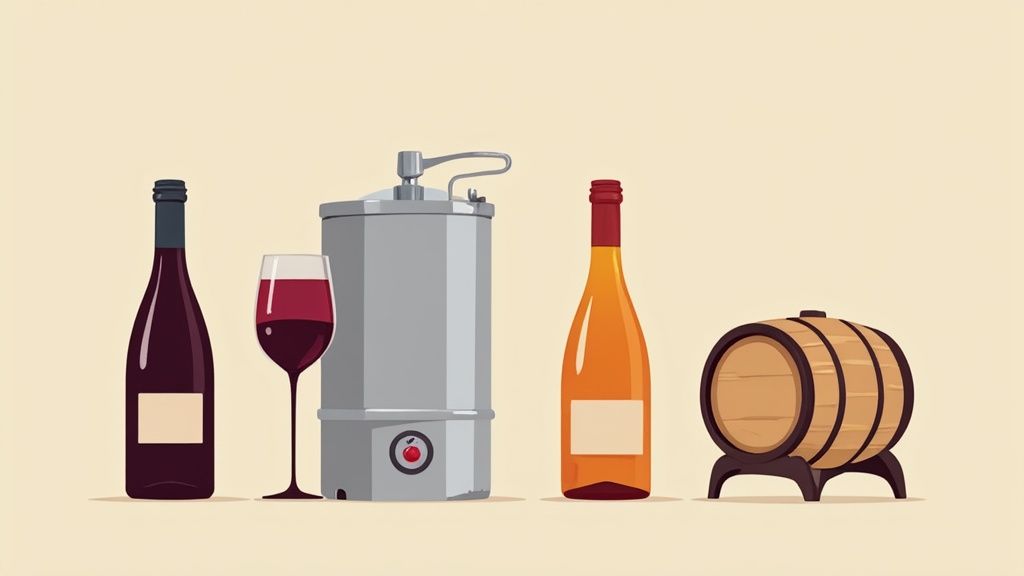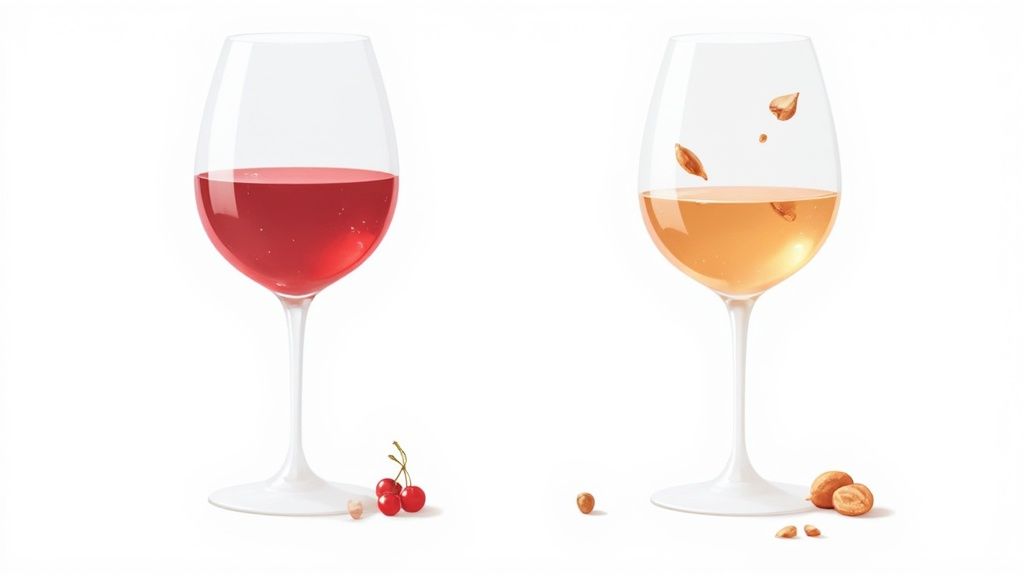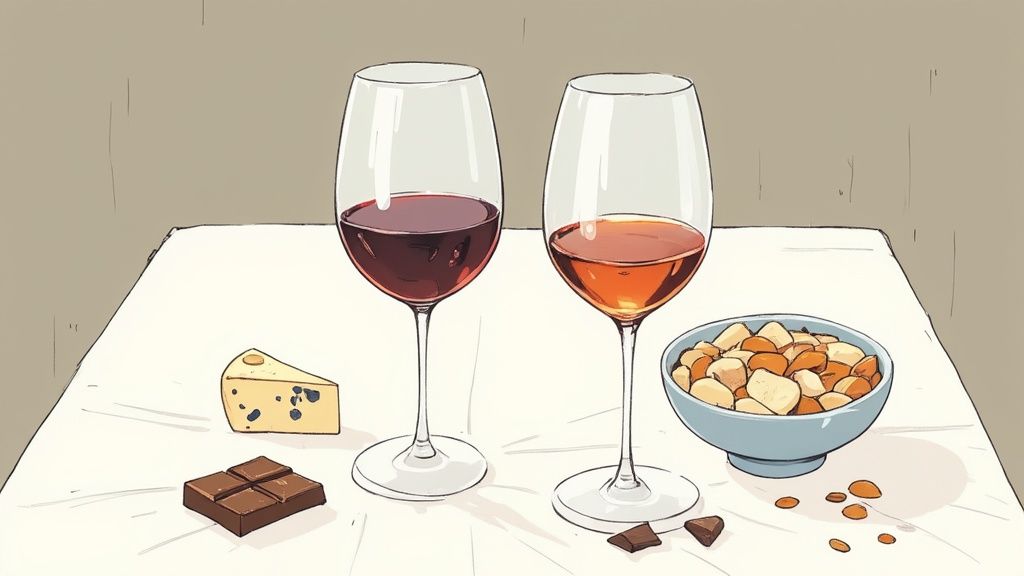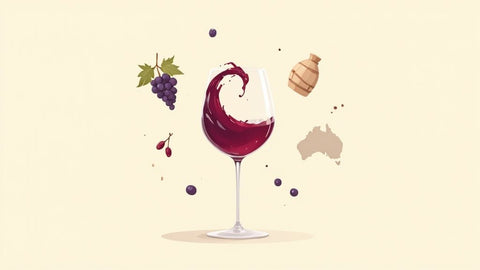The real heart of the difference between a Tawny and a Ruby Port boils down to a single, crucial factor: how it’s aged. Think of it as two paths diverging in the cellar.
Ruby Port takes the short path. It’s aged for just a couple of years in massive, oxygen-free tanks. This preserves its brilliant ruby-red colour and locks in all those intense, fresh-fruit flavours. Tawny Port, on the other hand, is in it for the long haul. It spends years, sometimes decades, relaxing in small oak barrels. This slow, gradual exposure to oxygen is what works the magic, softening the wine, developing complex nutty and caramel notes, and transforming its colour into a gorgeous amber-brown.
Decoding the Core Differences
Port, the classic fortified wine from Portugal's stunning Douro Valley, is really a tale of two families. Each offers a completely different experience, shaped almost entirely by that decision in the cellar. Getting your head around this is the key to picking the perfect bottle for any moment.

This initial aging choice creates a domino effect, influencing everything from colour and flavour to aroma and even the ideal serving temperature. A Ruby Port is all about youthful energy—it's bold, fruity, and in your face. A Tawny Port is its mellow, sophisticated older sibling, showcasing the complex, elegant character that only comes with time and patience.
If you're keen to learn more about the broader world of fortifieds, our complete guide to fortified wines is a great place to start.
For now, here’s a quick look at how these two Port styles stack up against each other.
Quick Comparison Tawny Port vs Ruby Port
To make things simple, this table breaks down the defining characteristics of each style side-by-side. It’s a handy cheat sheet for remembering the fundamentals.
| Characteristic | Ruby Port | Tawny Port |
|---|---|---|
| Colour | Deep, vibrant ruby-red | Pale amber to mahogany-brown |
| Aging Method | 2-3 years in large vats (reductive) | 3+ years in small oak barrels (oxidative) |
| Flavour Profile | Fresh berries, plum, chocolate, cherry | Dried fruit, caramel, nuts, cinnamon |
| Body | Full-bodied and robust | Silky, smooth, and lighter-bodied |
| Serving Temp | Slightly chilled (12-16°C) | Chilled (10-14°C) |
As you can see, while they both start life as the same base wine, the journey they take in the cellar leads them to entirely different destinations. One remains a bold celebration of fruit, while the other evolves into a complex, nutty, and elegant sipper.
How Production and Aging Shape Each Port
To really get to the heart of the difference between tawny and ruby port, you have to look at their journey from grape to glass. Both styles start their lives in Portugal's stunning Douro Valley, made from the same robust local grapes. But once they're fortified, their paths split dramatically. It's the choices made in the cellar that forge their final character.

This fork in the road is all about one thing: oxygen. The aging environment—specifically, the size and material of the vessel—dictates how much air interacts with the wine over time. This single variable is responsible for the profound differences in colour, flavour, and texture between the two.
The Ruby Port Method: Protective Aging
Ruby Port is all about preservation. Winemakers age it for a relatively short time, usually just two to three years, in enormous concrete or stainless steel vats. These massive, inert containers mean very little of the wine's surface is exposed to air, minimising oxygen contact.
This process is known as reductive aging. The goal is simple: lock in the wine's youthful vibrancy, its bold fruit flavours, and that deep, jewel-like ruby colour. What you get is a port that remains powerful, fresh, and fruit-forward, tasting very much like it did when it first went into the vat.
The Tawny Port Method: Oxidative Aging
Tawny Port, on the other hand, embarks on a much longer, more transformative journey. It’s aged in small oak barrels, known as pipas, for a minimum of three years but often for decades. These porous wooden barrels allow for a slow, controlled conversation with oxygen.
This prolonged 'oxidative' aging is what gives Tawny Port its signature nutty complexity, silky texture, and amber-brown hue. Oxygen softens the tannins, marries the flavours, and fundamentally shifts the wine's initial fruity personality into something far more nuanced and mellow.
This patient approach is a masterclass in evolution, with every year in the barrel adding new layers of complexity. To get a deeper sense of this process, you can explore the history of tawny port and see how this method was perfected over centuries.
Ultimately, one style champions the raw energy of youth, while the other celebrates a slow, elegant evolution.
Exploring the Flavour Profiles of Tawny and Ruby
When it comes down to tawny port vs ruby port, the tasting is where the real fun begins. Their completely different paths from grape to glass create two unique sensory experiences, each brilliant in its own way. Taking a sip of Ruby Port is like a burst of youthful energy—it's all about powerful, fruit-forward notes.
Think of a flavour explosion of ripe black cherry, raspberry, and juicy plum. These vibrant fruit flavours are backed by a full body and firm tannins, giving it a rich, almost chewy texture. It’s the bold, punchy choice, often finishing with a little hint of chocolate or spice.

Tawny Port, on the other hand, offers a much more nuanced and elegant experience, a direct result of its long, slow time spent maturing in oak barrels. That fresh fruit character has evolved into something far more complex and delicate.
The Nuances of Tawny Port
The soul of a Tawny lies in the secondary and tertiary notes that develop through gradual oxidation. You'll find intricate layers of flavour here that are simply impossible to get in a Ruby.
- Dried Fruits: Instead of fresh berries, you’ll taste things like dried figs, dates, and apricots.
- Nutty Character: Toasted almonds, walnuts, and hazelnuts are classic descriptors that come through beautifully.
- Confectionery Notes: Look for hints of caramel, butterscotch, toffee, and sometimes even a touch of honey.
This evolution in flavour has a fascinating history in Australian wine culture. Tawnies found a strong following here, especially after World War II, when European immigrants brought with them a taste for aged fortified wines. Rubies, in contrast, really took off from the 1990s as tastes shifted towards sweeter, more approachable wines for casual get-togethers. You can dig deeper into these market trends over at Global Insight Services.
The key takeaway is this: Tawny Port's flavour profile is a direct conversation between time and oxygen. The longer it rests in the barrel, the more the fresh fruit steps back, letting those complex, nutty, and caramelised notes take centre stage.
Understanding Aged Tawnies
The magic of Tawny really deepens when you get into "Tawnies with an Indication of Age." These are blends with an average age of 10, 20, 30, or even 40 years. With each decade, the wine becomes smoother, silkier, and infinitely more intricate. A 10-Year-Old might still have whispers of dried red fruit, but a 40-Year-Old will be exceptionally smooth, dominated by profound notes of toasted nuts, butterscotch, and exotic spices. It's a masterclass in aged wine.
Serving and Pairing Port for the Best Experience

This is where the real magic happens. Understanding how to serve and pair each style of port is what elevates the experience from a simple drink to a memorable moment. The unique character of both tawny and ruby port truly comes alive when you get the details right.
First things first: temperature. Unlike a lot of other red wines, both ruby and tawny ports are best served slightly chilled. This simple step is crucial—it lifts the aromatics and stops the alcohol from overpowering the delicate flavours.
Ruby Port Pairings
For a vibrant, fruit-forward Ruby Port, you'll want to aim for a serving temperature around 12-16°C. Popping it in the fridge for about 20-30 minutes before you pour is usually spot on. That slight chill really makes its bright fruit notes sing and provides a refreshing balance to rich foods.
When it comes to food, think bold and decadent. Ruby Port is a classic partner for:
- Rich Chocolate Desserts: Its intense berry notes cut straight through the richness of a gooey chocolate lava cake or a dense flourless torte.
- Strong Cheeses: The wine’s robust structure stands up beautifully to pungent blue cheeses like Stilton or Gorgonzola.
- Berry-Based Tarts: It beautifully complements the fruit in cheesecakes and tarts, making for a perfect match.
The key is to match Ruby's intensity. Its powerful, fruity profile needs a pairing that won’t get lost, making it an incredible choice for the end of a big meal.
Tawny Port Pairings
Tawny Port, with its more delicate, nutty character, is best served even cooler—ideally between 10-14°C. This cooler temperature highlights its complex notes of caramel, dried fruit, and toasted nuts, making it incredibly refreshing.
Its nuanced flavour profile calls for more elegant and complementary pairings. Tawny is absolutely exquisite with:
- Creamy Desserts: Think crème brûlée, custards, or a classic apple tart. Its nutty character adds a whole new layer of complexity.
- Aged Hard Cheeses: It’s a wonderful match for aged cheddar, Manchego, or a nutty Comté.
- Nuts and Dried Fruits: Sometimes, all you need is a simple bowl of toasted almonds or dried figs to let a quality Tawny really shine.
For a deeper dive into serving etiquette, including decanting and glassware, you can learn more about how to drink port wine in our complete guide. Choosing the right food and serving temperature will unlock the full potential of whichever port you pour.
How to Choose and Buy the Right Port
Walking down the port aisle can feel a bit overwhelming, but a few key terms on the label are all you need to tell the difference between a tawny and a ruby. Your final choice really just comes down to your personal taste, what you're celebrating, and how much you want to spend.
If a bold, fruit-forward experience is what you're after, then a Ruby Port is your go-to. This style is all about vibrant, accessible flavours that are perfect for a casual glass or pairing with a decadent dessert.
- Ruby Port: This is your entry-level style. It’s young, has a gorgeous deep red colour, and is absolutely bursting with fresh red and black fruit flavours.
- Reserve Ruby: A definite step up in quality. These are made from better grapes and aged just a little longer, giving you more concentration and complexity than a standard Ruby.
- Late Bottled Vintage (LBV): Made from a single harvest and aged for four to six years in wood. It’s a brilliant way to get a taste of a vintage style without the hefty price tag or the need for a cellar.
Finding the Right Tawny
On the other hand, if you prefer a smoother, more complex wine with those classic nutty and caramel notes, Tawny Port will be right up your alley. The label is your best guide to what's inside the bottle.
A basic Tawny Port is aged for at least three years, offering a lighter body with hints of nutty character. For a more profound experience, keep an eye out for age-indicated Tawnies—these are masterful blends with an average age stated right on the label.
An aged Tawny—labelled as 10, 20, 30, or 40 years old—is where you see the remarkable evolution that comes from extended time in oak barrels. With each decade, the flavours deepen, shifting from dried fruit to complex notes of almond, butterscotch, and spice.
Here in Australia, you'll see these differences reflected in the price. Recent data shows a basic ruby port often falls in the AUD $15-25 range. In contrast, premium aged tawnies average AUD $30-50 per bottle, a nod to their longer maturation time.
This pricing is also shaped by where port is sold, with about 54% of sales happening in restaurants and bars. If you're interested in the market dynamics, you can explore the latest port wine market report. Ultimately, choosing the right bottle is simply about matching these styles to your personal taste and budget.
Answering Your Top Port Questions
Even after exploring the differences between tawny and ruby port, a few practical questions always pop up. Let's tackle some of the most common queries to help you serve and enjoy your port like a pro.
One of the first things people ask is about decanting. For the vast majority of Ruby and Tawny Ports you'll buy, the answer is simple: no decanting is needed. These wines are filtered before bottling, so they’re ready to pour and enjoy straight away. The only exceptions are Vintage and Crusted Ports, which throw a natural sediment in the bottle as they age.
How Long Does Port Last After Opening?
This is where the way the port was made really comes into play. A Ruby Port, with its fresh and fruity character, is best enjoyed within about a week of opening. Think of it like a standard red wine once the cork is pulled.
Tawny Port, on the other hand, is a different story. Because it has already spent years ageing with gradual exposure to oxygen, it's far more resilient.
An opened bottle of Tawny Port will happily last for one to three months if you store it correctly in a cool, dark place or even in the fridge. This makes it a fantastic choice for those who just want to enjoy a small glass every now and then.
Can You Cook With Port?
Absolutely! Both styles work beautifully in the kitchen, but they bring different things to the table. Ruby Port is brilliant for creating rich, deeply coloured reductions and sauces for red meat or game, adding a real punch of bold berry flavours.
Tawny Port brings a more nutty, caramelised complexity. Use it to deglaze a pan for a pork dish, add incredible depth to mushroom sauces, or even drizzle it over roasted pears for a sophisticated dessert. Each style offers a unique flavour profile that can truly elevate your cooking.
Ready to explore the distinct flavours of Australian fortified wines? McLaren Vale Cellars offers a curated selection of premium ports from one of Australia's most celebrated wine regions. Discover your next favourite bottle today at https://www.mclarenvalecellars.com.




Comments (0)
There are no comments for this article. Be the first one to leave a message!